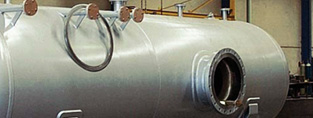
- (03) 5909 8218
- enquiry@fusionweld.com.au
The Importance of Pressure Equipment Inspection and Life Cycle Evaluation
October 23, 2015

Non-destructive testing techniques are key in the certification of pressure equipment. The evaluation techniques appraise the integrity of the manufacturing process, gauge the mechanical quality of materials used in the fabrication process, and thus form the basis for the commissioning of the manufactured vessel and its component parts.
Mechanically Ascertains Reliability Factors
It's a complex task, but the evaluation of possible mechanical defects is perhaps the most important phase of the design process. Much effort has gone into the pure geometry of the vessel, into creating a form that uniformly distributes pressure throughout the chamber, but if invisible defects do exist, no amount of engineering mathematics will prevent the integrity of the part from being compromised over time. Such defects could have disastrous effects on the vessel once it's installed and operating at its design pressure. After all, the welds, the crystalline substructure of the metal, all other discrete parts and relevant fixtures, they have to function as one when handling stresses incurred by pressurized fluids and gases. That stored material is likely to possess explosive potential, and a quantifiable pressure equipment inspection must be in place to catch defects and eliminate potential catastrophe. In short, mathematical surety is wonderful, but practical applications requires a more defined assurance phase, one that's lawfully regulated by local authorities in order to guarantee an ordained safety margin.
Life Cycle Evaluation Methodologies
The AICIP accredited inspection routines and pressure equipment management strategies incorporated by a conscientious engineering establishment represent a major application of company resources when invoking pressure equipment inspection expertise, but they don't show the full picture when setting out to document a comprehensive life cycle evaluation. Life cycle is directly shaped by equipment geometry and material selection, the welding techniques and fabrication processes we've just covered, but there's a great deal more to the technique than these factors. The final installation point is key in composing the evaluation. It factors in the location of the equipment, whether it will be above ground or installed below the surface. Environmental conditions affect life cycle figures, as do the material being stored in the pressure vessel. For example, the acidity of the soil will greatly reduce the life cycle of the equipment when the unit is buried under a mound of erosive soil and moisture. Cathodic protection assemblies may have to be added as a supplemental sacrificial anode to eliminate this threat and maintain the integrity of the vessel.
Inspection techniques call upon technology to measure material thickness with ultrasonic instruments and check the very crystalline substructure of the alloy. Meanwhile, the pressure equipment inspection process receives a boost of common sense from the installation site. Another example of this life extending ethic is the addition of rubber buffer plates to the equipment, vibration absorbers that protect the gear in seismically active regions.
Contact Details
Fusion - Weld Engineering Pty Ltd
ABN 98 068 987619
1865 Frankston Flinders Road,
Hastings, VIC 3915
Ph: (03) 5909 8218
Optimized by NetwizardSEO.com.au
Recent Posts
- Compressed Hydrogen Storage Vessels: Material Selection, Design & Australian Standards
- Welding QA/QC in Oil & Gas Pressure Vessel Fabrication – Ensuring Code Compliance
- AS1210 vs ASME VIII Pressure Vessel Code: Key Differences for Australian Projects
- Mitigating Hydrogen-Induced Cracking in Pressure Vessels: Engineering and Material Strategies
- Storage Tank Solutions Australia: Field-Erected, Prefabricated & Self-Bunded Explained
- Reducing Environmental Risks: Self-Bunded Tanks in Australian Oil & Gas Operations
- Precision in Production: How Pressure Vessels Are Manufactured for Industrial Safety
- Shell & Tube Heat Exchangers: Improve Thermal Control & Energy Recovery in Petrochemical & Pharmaceutical Plants
- In-Service Inspection for Compressed Air Receivers for Power Plant Shutdown Prevention
- Power Plant Pipe Spooling Fabrication – Get Rapid, Code-Compliant Spools Ready for Installation
- Field Erected Tanks: Safe, Reliable On-Site Fuel Storage Solutions in Australia
- Custom Pressure Vessel Fabrication for Flammable Gases
Posts 2025
- Compressed Hydrogen Storage Vessels: Material Selection, Design & Australian Standards
- Welding QA/QC in Oil & Gas Pressure Vessel Fabrication – Ensuring Code Compliance
- View all articles…
Posts 2024
- Large Process Vessels: Optimising the Design for Maximum Efficiency [2025]
- Pressure Equipment Management System Installation: Detect Equipment Faults Early
- View all articles…
Posts 2023
- Pressure Piping System Inspection: A Gift of Safety for the Holidays
- Deaerator Inspections by Fusion-Weld Engineering and How They Reduce System Downtime
- View all articles…
Posts 2022
- How Fusion Weld Keeps Up With AS-NZS ISO 9001:2008 Standard
- Boiler Equipment Safety Inspection During the Summer Season
- View all articles…
Posts 2021
- Avoid These Factors and Practices that Contribute to Sealing Damage in Pressure Vessels
- Do's And Don'ts Of Industrial Boiler Inspection And Maintenance From Fusion-Weld
- View all articles…
Posts 2020
- What are the Risks and Hazards Involved in Pressure Vessel Equipment?
- How to Know if Your Pressure Equipment Needs Repair or Replacement?
- View all articles…
Posts 2019
- Factors that Contribute to Pressure Vessel Failure
- Pressure Vessel Regulations in Australia: What are the Mandatory Requirements?
- View all articles…
Posts 2018
- Pros and Cons of Spherical vs. Cylindrical Pressure Vessels
- What are the Different Hazard Levels in Pressure Vessels?
- View all articles…
Posts 2017
- Transportable Pressure Vessels: The Importance of Inspection and Safety Checks
- Fracture Mechanics and Stress Analysis of Cracks in Pressure Vessels
- View all articles…
Posts 2016
Posts 2015
- What Are Deaerators & Feedwater Vessels?
- Precautions and Safety for Compressed Air Receiver Vessels
- View all articles…
Posts 2014
- Demonstrating In-process Inspection Procedures
- Static Grounding Practices and Standards
- View all articles…